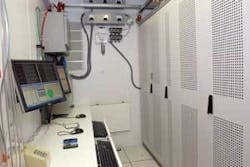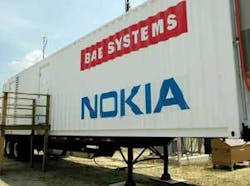BAE Systems adopts Nokia commercial equipment to service military customers
By Courtney E. Howard
MERRIMACK, N.H. - BAE Systems engineers and executives tapped the latest commercial communications and networking technologies from Nokia of Irving, Texas, in developing the BAE Systems mobile area communications (MAC) trailer, resident at its Merrimack, N.H., facility.
The BAE Systems MAC trailer, a test bed of cellular telephone and network equipment, will help BAE Systems to provide secure, immediate, and wireless communications to military and other government customers. MAC also will help company engineers advance their signal processing and antenna technologies.
Through the use of Nokia technologies in the MAC solution, BAE Systems and its customers can take advantage of the cost savings, high availability, and rapid upgrade cycles available from today’s commercial hardware and software solutions.
Based on an agreement with BAE Systems, Nokia built and supplied a Global System for Mobile/General Packet Radio Service/Enhanced Data rate for GSM Evolution (GSM/GPRS/EDGE) network that seamlessly integrates a server system, core network, radio network, and Nokia NetAct network and service management system in a self-contained, easily deployable configuration.
Nokia’s Public Land Mobile Network (PLMN) provides radio-frequency-to-network connectivity by taking advantage of the GSM open standard. The most widely used mobile telecommunications standard in the world, more than 2 billion people use GSM across more than 210 countries and territories to date. For this reason and others, such as its support of current and future IP-centric trends, BAE Systems executives decided to proceed with a GSM-based solution and to partner with the leading supplier of GSM capabilities, Nokia.
The MAC trailer has a wealth of electronics, which line the walls of the structure’s interior and leave only a narrow walkway for the two engineers who run the system. The engineers monitor the system and provide operational support using two workstations with liquid-crystal displays (LCDs) at one end of the trailer. The operations support system also enables users to monitor the entire solution remotely via a secure virtual LAN (VLAN) connection.
A well-organized test bed, the trailer has some of the latest telecommunications and networking technologies and electronics innovations working in tandem. Among them is a base station, or the central base receiver system; a transceiver that transmits and receives data; RF-to-fiber coax equipment for reaching high frequencies; a transcoder interconnect switch (TCSM); a cross-connection panel; core packet equipment, and services that serve as a multimedia gateway; a Wireless Code-Division Multiple Access (WCDMA) radio network controller that enables real-time video streaming; and the mobile switching center server, which is described by Nokia’s Jovi Espinosa as “the heart and soul of the system.”
The trailer also is configured with two omni antennas mounted on a 60-foot pneumatic mast and configured to operate in 900 and 180 MHz (non-U.S.) bands. The substantial networking hardware gets power from the trailer’s self-contained generator, while built-in environmental controls keep the electronics cool.
The BAE Systems portable communications and networking solution connects users-such as emergency response personnel, victims of catastrophic events, and government, defense, and homeland security officials, among others-to an ISP through the network to provide cell-phone service and access to the Internet.
The components work together using an infrared laser system to ensure that network phones are registered users. Components also perform location updates on the phones, monitor the subscribers to maintain security, and compress and digitize the data into bits prior to transmission.
The test-bed core network can support as many as 12,000 simultaneous calls and, at maximum power, can provide coverage over a radius as far as five miles. Its MSC-Server/Media Gateway (MSS/MGW) can support as many as 600,000 subscribers, whereas the Home Location Register (HLR) can support as many as 2.4 million subscribers; yet, the current configuration provides support for a maximum of 150,000 subscribers.
Purchased in commercial transaction, the MAC trailer marks a $3 million investment that includes documentation and training. BAE Systems also purchased a three-year support contract, estimated at $1 million, through which Nokia will provide software upgrades and technical support.
BAE Systems acquired the MAC trailer, which has been integrated into the Merrimack facility’s radio frequency (RF) and network test infrastructure, with the goal of learning more about today’s most advanced cellular and computer-based network communications technologies.
The MAC trailer is credited with fueling research and development into improving cellular communications systems, as well as supporting BAE Systems Information Operations Initiative’s communications and network vulnerability analysis and signal processing research.
BAE Systems is using the MAC test bed as an external test facility for the research and development of communications and networking, signal processing, antenna, and information assurance technologies. Company personnel anticipate its use for testing government and third-party capabilities, to develop homeland- security technologies, and to provide cellular service in emergency situations.
“Nokia’s GSM/EDGE network enables us to utilize an industry-leading platform in support of our ongoing activities with U.S. government entities,” says Rance Walleston, director of The BAE Systems Information Operations Initiative. Further, it aids the company in leveraging commercial technology for government applications.
This initial contract with BAE Systems is indicative of Nokia’s efforts in and dedication to adapting its latest commercial innovations to fit government applications. Nokia, working to expand its reach in the U.S. government sector, seeks to apply its portfolio of communications and core network solutions to strengthen the capabilities of the government sector.
According to BAE Systems and Nokia representatives, the companies will cooperate on furthering waveform optimization for signal processing, antenna, and networking technologies.
For additional information, visit www.na.baesystems.com and www.nokia.com.


